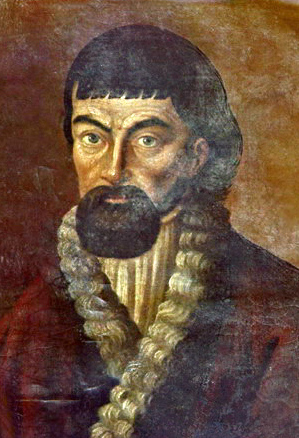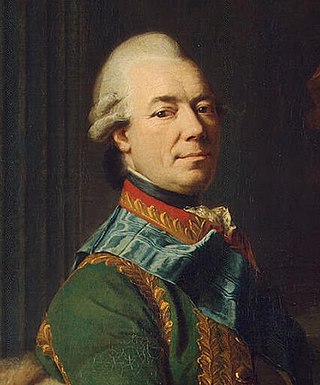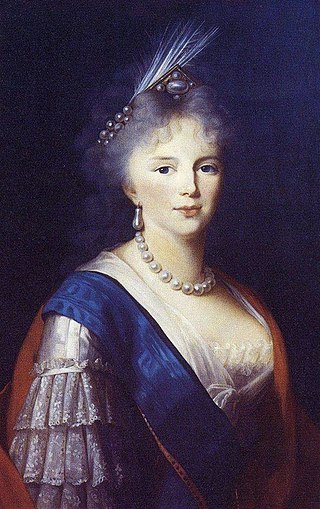| |||||
| Decades: | |||||
|---|---|---|---|---|---|
| See also: | |||||
This is a list of notable events from the year 1777 in Russia .
| |||||
| Decades: | |||||
|---|---|---|---|---|---|
| See also: | |||||
This is a list of notable events from the year 1777 in Russia .

Yemelyan Ivanovich Pugachev was an ataman of the Yaik Cossacks and the leader of the Pugachev's Rebellion, a major popular uprising in the Russian Empire during the reign of Catherine the Great.

Zakhar Grigoryevich Chernyshev was a Russian noble, courtier to Catherine the Great, Imperial Russian Army officer, and Imperial Russian politician in the 18th century.

Tsarskoye Selo was the town containing a former residence of the Russian imperial family and visiting nobility, located 24 kilometers (15 mi) south from the center of Saint Petersburg. The residence now forms part of the town of Pushkin. Tsarskoye Selo forms one of the World Heritage Site Saint Petersburg and Related Groups of Monuments.

Pavlovsk is a municipal town in Pushkinsky District in the suburban part of the federal city of St. Petersburg, Russia, located 30 kilometers (19 mi) south from St. Petersburg proper and about 4 kilometers (2.5 mi) southeast from Pushkin. Population: 16,087 (2010 Census). Known since the late 18th century, when Saint Petersburg was the capital of Russian Empire, as a countryside residence of Russian royal family commissioned creation of the town's landmark -palace with a large park, now parts of its federal museum reserve.

Maria Feodorovna became Empress of Russia as the second wife of Emperor Paul I. She founded the Office of the Institutions of Empress Maria.

The Alexander Palace is a former imperial residence near the town of Tsarskoye Selo in Russia, on a plateau about 30 miles (48 km) south of Saint Petersburg. The Palace was commissioned by Catherine the Great in 1792.

Count Pyotr Andreyevich Shuvalov was an influential Russian statesman and a counselor to Tsar Alexander II.

Charles Cameron was a Scottish architect who made an illustrious career at the court of Catherine II of Russia. Cameron, a practitioner of early neoclassical architecture, was the chief architect of Tsarskoye Selo and Pavlovsk palaces and the adjacent new town of Sophia from his arrival in Russia in 1779 to Catherine's death in 1796. Cameron concentrated exclusively on country palaces and landscape gardens. Twice dismissed by Paul of Russia during the Battle of the Palaces, Cameron enjoyed a brief revival of his career under Alexander I in 1803–1805. All his indisputable tangible works "can be encompassed in a day's tour".

Pavlovsk Palace is an 18th-century Russian Imperial residence built by the order of Catherine the Great for her son Grand Duke Paul, in Pavlovsk, within Saint Petersburg. After his death, it became the home of his widow, Maria Feodorovna. The palace and the large English garden surrounding it are now a Russian state museum and public park.

Princess Anna Petrovna Lopukhina was a royal mistress to Emperor Paul of Russia. In 1798, she replaced Catherine Nelidova as the chief mistress.

Yelagin Palace is a Palladian villa on Yelagin Island in Saint Petersburg, which served as a royal summer palace during the reign of Alexander I. The villa was designed for Alexander's mother, Maria Fyodorovna, by the architect Carlo Rossi. It was constructed in 1822 on the site of an earlier mansion built during the rule of Catherine the Great. The house was destroyed during World War II but was rebuilt and currently houses a museum.

Princess Helen of Serbia was a Serbian princess. She was the daughter of King Peter I of Serbia and his wife, the former Princess Ljubica of Montenegro. She was the elder sister of George, Crown Prince of Serbia and King Alexander I of Yugoslavia. Helen was also a niece of Queen Elena of Italy, Princess Anastasia of Montenegro, wife of Grand Duke Nicholas Nikolaevich of Russia and of Princess Milica of Montenegro, wife of Grand Duke Peter Nikolaevich of Russia, the women who introduced Grigori Rasputin to Tsarina Alexandra.

The Russian Empire was a vast empire that spanned most of northern Eurasia from its proclamation in November 1721 until the proclamation of the Russian Republic in September 1917. At its height in the late 19th century, it covered about 22,800,000 square kilometres (8,800,000 sq mi), roughly one-sixth of the world's landmass, making it the third-largest empire in history, behind only the British and Mongol empires. It also held colonies in North America between 1799 and 1867. The empire's 1897 census, the only one it conducted, found a population of 125.6 million with considerable ethnic, linguistic, religious, and socioeconomic diversity.

The "Battle of the Palaces" occurred in the Russian Empire in the last decade of the reign of Catherine II (1784–1796) and the reign of Paul I (1796–1801), with ripple effects extending into the beginning of the reign of Alexander I. A bitter standoff between Catherine and Paul, her only legitimate son and heir, manifested itself in transient political and ideological conflicts, but also had a lasting, tangible impact on Russian architecture. Both parties materialized their political statements and their understanding of sovereign power in expensive construction projects involving the most illustrious architects of the period – Vasily Bazhenov, Vincenzo Brenna, Charles Cameron, Matvey Kazakov, Giacomo Quarenghi, and Ivan Starov. Catherine's palace projects followed the neoclassical canon of the Age of Enlightenment, while Paul deliberately leaned to emerging Romanticism. Buildings that stylistically fell apart from these programs were demolished or rebuilt without hesitation. The "battle" began in 1785 with the demolition of the main palace in Tsaritsyno, and culminated in 1796 with the demolition of Pella, the largest imperial palace in the Saint Petersburg area.

The Tsarskoye Selo Railway was the first public railway line in the Russian Empire. It ran for 27 km (17 mi) from Saint Petersburg to Pavlovsk through the nearby (4 km) Tsarskoye Selo. Construction began in May 1836, and the first test trips were carried out the same year between Tsarskoye Selo and Pavlovsk, using horse-drawn trains. The line was officially opened on 30 October 1837, when an 8-carriage train was hauled by a steam locomotive between Saint Petersburg and Tsarskoye Selo. Until the construction of the Moscow – Saint Petersburg Railway in 1851, it was the only passenger train line in Russia. In 1899 it was merged into the Moscow-Windau-Rybinsk Railways and now forms part of the Oktyabrskaya Railway.

The Pavlovsk Park is the park surrounding the Pavlovsk Palace, an 18th-century Russian Imperial residence built by Tsar Paul I of Russia near Saint Petersburg. After his death, it became the home of his widow, Maria Feodorovna. It is now a state museum and a public park.

The emperor and autocrat of all Russia, also translated as emperor and autocrat of all the Russias, was the official title of the Russian monarch from 1721 to 1917.

Alexander II was Emperor of Russia, King of Congress Poland and Grand Duke of Finland from 2 March 1855 until his assassination in 1881. Alexander's most significant reform as emperor was the emancipation of Russia's serfs in 1861, for which he is known as Alexander the Liberator.

Events from the year 1825 in Russia
![]() Media related to 1777 in Russia at Wikimedia Commons
Media related to 1777 in Russia at Wikimedia Commons